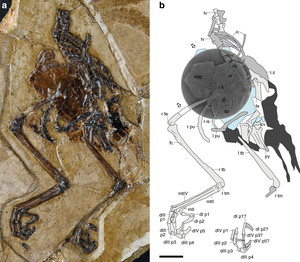Avimaia
| Avimaia | ||||||||
|---|---|---|---|---|---|---|---|---|

Fossil of Avimaia schweitzerae with an unlaid egg |
||||||||
| Temporal occurrence | ||||||||
| Lower Cretaceous ( Aptium ) | ||||||||
| approx. 115 to 110 million years | ||||||||
| Locations | ||||||||
| Systematics | ||||||||
|
||||||||
| Scientific name | ||||||||
| Avimaia | ||||||||
| Bailleul , O'Connor , Zhang , Li , Wang , Lamanna , Zhu & Zhou , 2019 | ||||||||
| Art | ||||||||
|
||||||||
Avimaia is an extinct genus of the enantiornithes . The generic name is derived from the Latin avis "bird" and Maia from Greek mythology, as an allusion to the unlaid egg found in the fossil.
The only known species is called Avimaia schweitzerae . The species name honors Mary Higby Schweitzer for her role in the field of molecular palaeontology .
It was named and described in 2019 by Alida M. Bailleul, Jingmai Kathleen O'Connor, Zhang Shukang, Li Zhiheng, Wang Qiang, Matthew C. Lamanna, Zhu Xufeng and Zhou Zhonghe.
remains
The fossil (holotype IVPP V25371) was discovered in 2006 in the Xiagou Formation , which is located in what is now China. It consists of a partial skeleton without a skull with remains of the plumage and an egg. The remains are estimated to be around 110 to 115 million years old.
egg
It is the first time that an egg has been found in the abdominal cavity of a fossil bird. The egg is crushed and lies between the pubic bones of the specimen. The special thing about the finding is that the egg shell has been preserved. It consists of three layers, like modern birds, and is about 0.05 mm thick. The shells of other enantiorniths were always thicker.
The crushing of the egg resulted in four to six eggshells that are stacked on top of each other. This unusual stacking led to the hypothesis that there were two eggs. This was refuted, however, because the layers of the upper two shells would have to be mirrored, which was not the case. It is also known that Eumaniraptora only had one functioning fallopian tube.
Size and special features
Avimaia were small birds that were less than eight inches . The pubic bone is slender and curved upwards, creating a hollow profile over its entire length. The rear end of the ischium is curved upwards. It differs from its relatives in some features: the sacrum consists of eight sacral vertebrae. The first metatarsus is J-shaped with its lower end two-thirds the length of the shaft, which is a relatively small ratio.
Individual evidence
- ↑ a b c d e f g Alida M. Bailleul, Jingmai O'Connor, Shukang Zhang, Zhiheng Li, Qiang Wang, Matthew C. Lamanna, Xufeng Zhu & Zhonghe Zhou: An Early Cretaceous enantiornithine (Aves) preserving an unlaid egg and probable medullary bone . In: Nature Communications . 10, March 20, 2019, p. 1275. doi : 10.1038 / s41467-019-09259-x . Retrieved June 16, 2019.